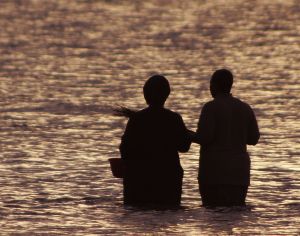 The rite of baptism evokes some familiar images. Many might picture an infant being held over a font in a church surrounded by clergy, family and witnesses. Another scene may show a group of people up to their waists in a river, waiting to be immersed in the waters. The scenario may take many forms, but it may be said that they all share a common thread, which is the desire for renewal.
The rite of baptism evokes some familiar images. Many might picture an infant being held over a font in a church surrounded by clergy, family and witnesses. Another scene may show a group of people up to their waists in a river, waiting to be immersed in the waters. The scenario may take many forms, but it may be said that they all share a common thread, which is the desire for renewal.
Spiritual in All Traditions
While baptism may have some fairly specific guidelines depending upon the religious tradition of its practitioners, it is a rite that may be open to anyone who asks for it. At its heart, this practice is a blessing that need not come from any traditionally organized source. Because of this, most religious organizations allow laypeople to perform the ceremony in situations where clergy are unavailable, such as a deathbed. An ordained minister may provide baptism for people of any or no religious affiliation. We are often asked by our ministers at the Universal Life Church how to perform a baptism. We hope this quick guide on performing a baptism will be helpful to you.
Elements of Baptism
The practice of baptism may hold different significance for different people, depending on their backgrounds and situations, but certain elements are typically shared no matter what the circumstance. The most important of these may be water. Water may be derived from virtually any source, so long as it is relatively clean. Sources include:
- River water
- Well water
- Tap water
- Distilled water
How the water is administered may depend on several things, such as cultural or religious practices and time or space constraints. There are three basic ways to administer the water:
- Sprinkling, or aspersion
- Pouring, or affusion
- Dunking, or immersion
Another substance often incorporated into the ceremony is oil, which may be used in addition to water (or in lieu of it, in some cases) to anoint the person being baptized.
The History of Baptism
Bathing in waters for the purpose of spiritual cleansing has long been part of many religious traditions, including the Jewish faith. It is perhaps most commonly associated, however, with the event that is considered to be the beginning of Jesus Christ's ministry. According to Christian gospel in the New Testament, when John baptized Jesus in the River Jordan, it was seen to be a sign of the covenant with God. The practice came to symbolize a cleansing of the soul for new members of the church. Traditions have different practices for when one should be baptized within their faith. Some people believe the rite should occur when the recipient is old enough to express intention. Others perform the ceremony at infancy, two or so weeks after birth.
Who May Baptize
Technically, in many circumstances, anyone with the use of reason who is able to perform a baptism may do so. That said, an ordained minister may be equipped to provide comfort and solace at home or in a hospital through a familiarity with a protocol that one who is not ordained may lack. In any case, the focus is to fulfill a request and provide a blessing with the compassion and kindness that may allow an individual to feel more at peace. Usually, a witness or witnesses may further validate the baptism.
The Three C's of Baptism
Three informal tenets of baptism may be creation, commitment and community. Whether the rite occurs at the beginning of life or at its end, it may be seen as a practice to help us define ourselves, transform ourselves and create ourselves. It may demonstrate a commitment to shared values and shared love, and may also be a symbol of our connection to our community, in which we may rejoice, grieve and grow together.
Add Your Comment